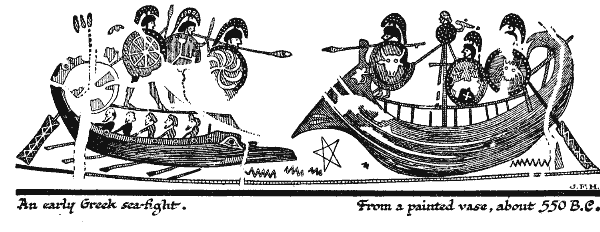

PROTECTED ROWERS: Yes, later ships had overhead decking to protect the rowers from missile fire. This is not calculated in these rules since the only Crew Strength that is used is On Deck Crew Strength. These are the soldiers who do the missile firing and the melee in boarding, etc. Oarsmen are generally naked, and poorly armed if armed at all, so they are treated as a part of the ship and suffer whatever fate the ship will suffer.
COMMAND & CONTROL: These rules were more or less designed for small numbers of miniatures, more like skirmish gaming, than huge fleet actions. Thus there are no command & control features. Each ship may act in formation with others or may act independantly such as in a WW1 aerial dogfight. However, should you want to use larger numbers of figures and wish to implement some command & control, here are a few Ideas:
Flagship: Usually your largest ship. This is the overall command ship. If the number of ships you are gaming with are 10 or less, you need only this ship.
Command ships: If you have more than 20 ships, you may want to designate a Flagship, and a Command ship for every 10 ships.
The Command & Control Radius of a Flagship is 6 inches. The Command & Control Radius of a Command ship is 3inches.
Any ship within the Command & Control radius of either flag or Command ship, will act as normal, and perform whatever task you wish. Any ships that are beyond such radius, will only perform the task that you declare for it, once you roll a 1D6.
5-6 = The ship will move and/or attack, as you wish.
4 = The ship will move only, but will not attack in anyway.
2-3 = The ship will do nothing. Treat as immobile.
1 = The ship will move, or attack the nearest enemy ship regardless of its size and any orders to the contrary.
NOTE: During the game, if the Flagship is lost roll 1D6 for each ship in the fleet. On a roll of 6 that ship is removed from play as having left the battlefield due to loss of will to fight.
 In this image, A is the command ship. All 'B' ships
are in the Command Radius. The ship marked 'C' is not.
In this image, A is the command ship. All 'B' ships
are in the Command Radius. The ship marked 'C' is not.
Ancient Naval Warfare, was usually conducted in Linear Tactics much like Land Warfare. Ships were normally used as artifiscial land to bring soldiers to eachother for hand to hand land style combat. (called Boarding & Melee in these rules) The formations aided Command & Control and thus, it aided movement. You can incorporate these movement benefits without command & control rules if desired. The Formations used for movement are the Line and the Column.
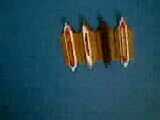 This is
a Line. This line is very Tight (ships touching) but the line can
work with up to an Inch between the figures.
This is
a Line. This line is very Tight (ships touching) but the line can
work with up to an Inch between the figures.
 This is a
Column. The figures are touching bow to stern as they move in 90
degrees one behind the other. The line can work with up to an
inch between figures as well.
This is a
Column. The figures are touching bow to stern as they move in 90
degrees one behind the other. The line can work with up to an
inch between figures as well.
Another Formation was purely Defensive and consisted of all ships forming a circle (360 degree defence) with their bows pointing out. In Greek, this formation was called a KYKLOS.
LINE FORMATION: All ships may move forward at the rate of the slowest vessel only. No veerance is allowed for forward movement. The inner ships sides are protected from ramming and oar swiping. Ships wishing to break formation may do so at anytime by moving 90 degrees to the rear, or by charging to the front within a normal 30 degree veerance. Ships can turn individually 90 degrees to form a COLUMN. (remember, all moves are at the lowest speed or turn of ships involved. Turning takes 1 movement turn)
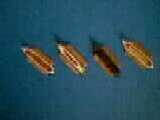 Ships in the middle of a 90 degree turn from LINE
to COLUMN.
Ships in the middle of a 90 degree turn from LINE
to COLUMN.
Their are no Wheeling type turns to make an entire Line change directions and keep the Line formation. Ships must form Column then may turn 90 degrees in COLUMN BY THE LEAD. In this action, the lead ship turns the desired direction. On the Next turn, the following ship turns, and the lead ship is advanced to allow the ship to follow in the turn. (see images below)
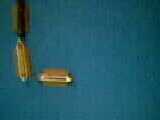
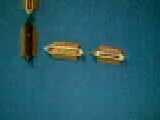
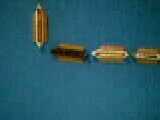 Once the
new COLUMN forms in the new, desired direction, it may change to
LINE with a simultaneous 90 degree turn by each ship, as noted
above.
Once the
new COLUMN forms in the new, desired direction, it may change to
LINE with a simultaneous 90 degree turn by each ship, as noted
above.
NOTE: Ships moving in COLUMN bow to stern and not more than 1 inch apart, receive a 1 inch bonus to their movement.
Ships in Column may break formation whenever they want by veering out of line 30 degrees. Once free of the line it may act as it wishes, but looses the 1 inch movement bonus.
ARTILLERY: As in Land Warfare, ancient navies used Artillery such as Bolt throwers and Stone throwers lashed to the decks of their biggest ships (In these rules only Quadremes and Quinqremes may carry One Artillery piece.) You as a player may decide which kind of piece the ship carries but note the following:
Quadremes loose 1 inch of movement if loaded down with a Stone thrower.
These weapons are Missile weapons and one shot may be made any turn that a target is in range. The Ranges are as follows:
Bolt Throwers = 3 inches.
Stone Throwers = 2 inches.
Both types of throwers may shoot NORMAL or FIRE shots. Fire shots may catch the target ship on fire as noted in the MISSILE & FIRE SECTION. However, these weapons receive a +2 to the chance of the target ship catching fire. Normal shots do not catch the target ship on fire, but both types of shot will cause damage if they actually hit the target ship. First Roll for a hit.
Roll 1D6 to Hit Target ship.
4 - 6 = A Hit!
1 - 3 = A Miss!
Modify this roll by the following:
Stands touching = +1
1 inch apart = 0
2 inches = -1
3 inches = -2
For successful HITS by a Bolt Thrower Roll 1D6 for Crew Casualties on the Target ship.
For successful hits by a Stone Thrower Roll 1D6 +2 for Crew Casualties and Then roll for Ship Damage.
5-6 Ship is holed in the bottom and sinks.
3-4 Ship is immobilized 1 turn due to damage.
1-2 only Crew Casualties are sustained.
THE DOLPHIN
The DOLPHIN is a heavy lead or bronze weight in the shape of a Dolphin that is hung from a boom on a ships mast. The mast must be permanant and solid thus this is not really a Warship weapon, but a Merchantman (Sailing ship only) Weapon. However, for these rules, a Quinqreme with its mast in place and who choose not to have an artillery piece, may arm itself with one Dolphin. Merchant ships may also have one Dolphin on board. When Merchantmen have a Dolphin on board they must reduce all movement by 1 inch. The Dolphin can only be used when the owning ship is touching side by side with a target ship. The owning player then announces he is dropping his DOLPHIN. Roll 1d6.
 3-6
the target ship sinks. 1-2 the target ship is immobile 1 turn.
3-6
the target ship sinks. 1-2 the target ship is immobile 1 turn.
BIOLOGICAL WEAPONS
Lets stretch the historical account here a little and have some fun. A ship may move to the side of another ship, as above, and instead of the normal missile fire it may use one biological weapon attack. Decide at the beginning of the game if such weapons are allowed. Each ship may have one weapon as such. Roll 1D6 per ship to decide which kind it has and note it on a roster.
6 = Bag of African Killer Bees.
5 = Greek Fire.
4 = Bag of Cobras.
3 = Bag containing European Bees.
2 = Bag of Other Snakes.
1 = Bag of Scorpions.
African Killer Bees permanantly immobilize any ship. Crew suffers 1D6 casualties every turn unless transfered off.
Greek Fire gets a +3 to setting a ship on fire and the crew gets a -1 for every attempt to put it out.
Cobras cause a ship to be immobilized for 3 turns. The crew suffers 1D6-2 casualties each turn.
European Bees cause a ship to be immobilized for 2 turns.
Other snakes immobilize the ship for 1 turn and cause 1D6-2 casualties.
Scorpions immobilize the ship for 1 turn.
NOTE: These immobilizations are obviously due to the crew dealing with the little buggers thrown on board. While immobile a ship can easily be rammed or grappled.
SAILING
Sails are used for movement by warships when not in a battle. Warships leave their masts, sails and rigging ashore when going into battle. Some of the large warships may still have their masts in place, but the sailing and rigging are taken off or stowed. their is no time in battle for Sails to be rigged or remasted. The exception to this is PIRATE SHIPS AND PIRATE CATCHERS. Merchantmen are generally sailers only. They have a limited ability to row with oars. All sailing is done respective of the Wind.
WIND: I f there is to be Sailing or the possibility of Sailing, determine which direction is North on the board, and then Roll 1D6 for the direction of the wind.
6 = No wind, roll each turn for the wind to appear.
5 = Wind to the North.
4 = Wind to the West.
3 = Wind to the East.
2 = Wind to the South.
1 = Wind direction by players choice.
Now that you know the direction of the wind, place an arrow on the board in that direction which everyone can refer too.
Ships move WITH THE WIND, VEER TO THE WIND, ASIDE THE WIND, OFF THE WIND. Sailing ships may move forward only with no veerance. It takes a full turn for a sailing ship to change direction, but they may change left or right up to 180 degrees.
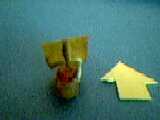 WITH THE
WIND. This ship is running parallel with the wind and can move
upto 12 inches.
WITH THE
WIND. This ship is running parallel with the wind and can move
upto 12 inches.
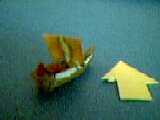 VEER TO THE
WIND. This ship is running oblique with the wind at a veerance of
30 degrees, it may move 10 inches.
VEER TO THE
WIND. This ship is running oblique with the wind at a veerance of
30 degrees, it may move 10 inches.
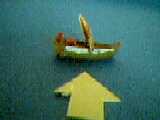 ASIDE THE
WIND. This ship is moving perpendicular to the direction of the
wind or 90 degree angle to it, it may move 6 inches.
ASIDE THE
WIND. This ship is moving perpendicular to the direction of the
wind or 90 degree angle to it, it may move 6 inches.
 OFF THE
WIND. This ship is running at an angle between 91 and 130 degrees
(0 is the direction of the wind) It may move 3 inches.
OFF THE
WIND. This ship is running at an angle between 91 and 130 degrees
(0 is the direction of the wind) It may move 3 inches.
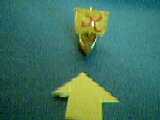 No
Movement is allowed for Sailing ships beyond 130 degrees into the
wind.
No
Movement is allowed for Sailing ships beyond 130 degrees into the
wind.
Merchantmen full of cargo loose 1 inch of movement; however, cargo may be tossed overboard in 2 consecutive turns of no movement by declaring so.
PIRATE AND PIRATE CATCHERS.
These are nimble Biremes that have special masts and a section of oarsmen used as both Deck hands and Oarsmen. The ship may thus, in 1 turn of non-movement, put up or take down its mast and sailing rig.
When running to catch up with a merchantmen or to get away from an oared warship, the sail is used. When wishing to Ram or grapple and board another ship (said merchantmen) the mast must be taken down.
Pirate Catchers were Military Biremes built like the Pirate ships in order to catch the pirate ships. Pirate Catchers are the only Biremes that have a Crew Strength of 15 rather than 10.
A merchantman that is grappled and boarded has no defencive melee as they have no Crew Strength. (unless a crafty Sea Commander has hidden soldiers on the ship. In this case up to 10 may be put aboard)
A Merchantmen with Soldiers on board looses an additional inch in movement.
OPTIONAL WIND RULES
Wind may be finicky. You may choose to roll the dice each turn to see if the wind changes direction or dries up. If it dries up, no sailing may occur. If it changes directions Roll 1D6 on the wind direction roll above.
4-6 = No Change.
2-3 = Changes Direction
1 = Dies.
NOTE: Merchantmen have limited Oar capabilities. Thus they may only move without wind or against the wind, 1 inch per turn.
TOWING
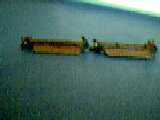 Oared ships may
tow another ship touching its stern. The towed ship moves in the
direction of the towee. This affects the ships movement depending
on its size.
Oared ships may
tow another ship touching its stern. The towed ship moves in the
direction of the towee. This affects the ships movement depending
on its size.
BIREMES: Loose 50% of forward movement. They may only tow 1 other ship. They can not turn and move in the same movement. They may only turn in 90 degrees. It takes two turns for both ships to turn before forward movement may be conducted.
TRIREME: Have a -2 inches to their forward movement if Towing 1 ship, and a -50% if towing 2 ships. They may only turn in 90 degrees. It takes 1 movement per ship to turn.
QUADREMES: No movement affected for 1 ship being towed, -1 inch if 2 ships are being towed. turning is the same as for triremes.
QUINQREMES: No movement affected for towing 1 ship, -1 inch for 2 ships, -2 inches for towing 3 ships. Turning is the same as for Quadremes.
I think that should do her for OPTIONAL RULES Hope you enjoy playing the game. Good Luck!
Click here to go back to the main page.